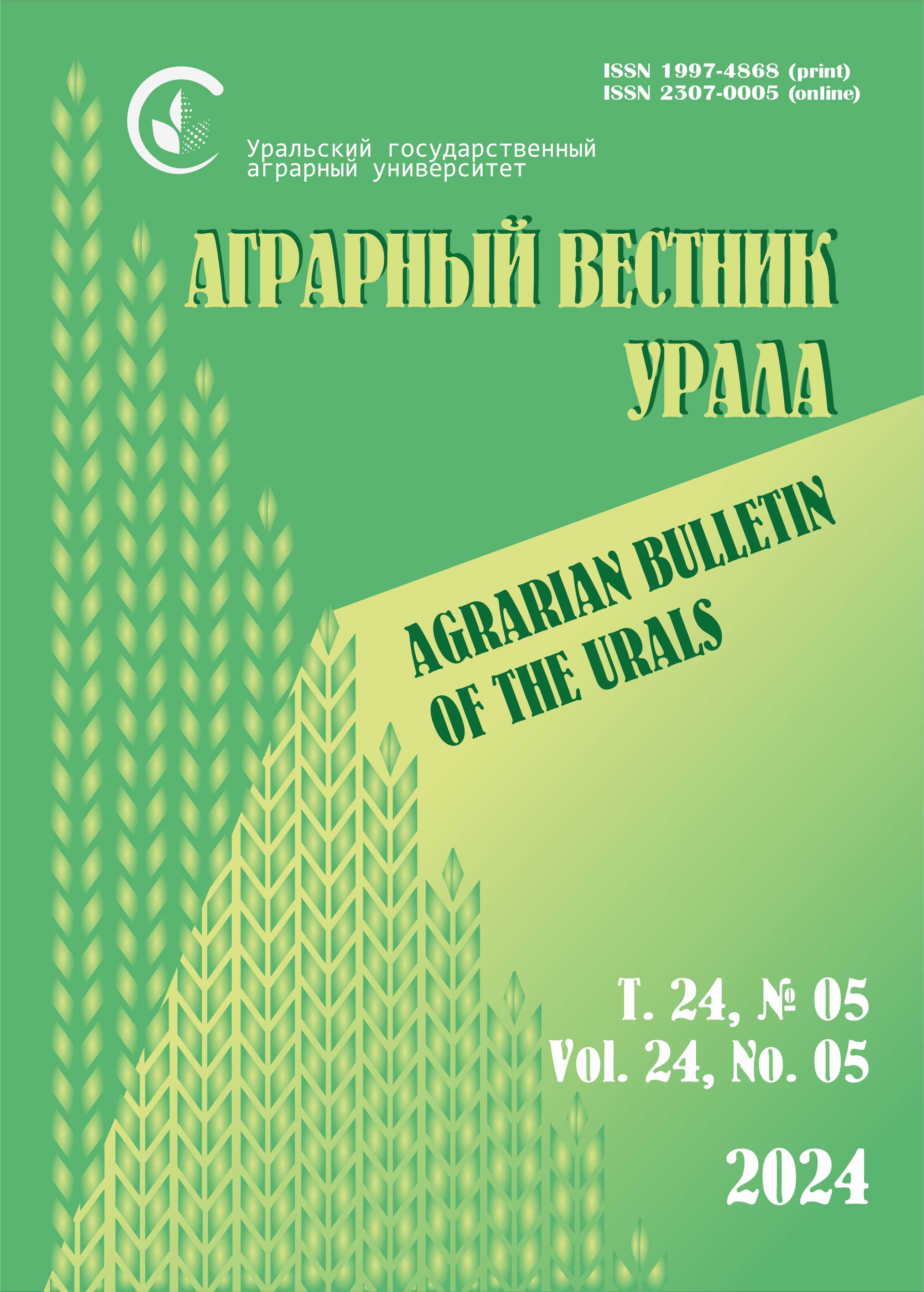Abstract. Various climatic indices are used to monitor meteorological drought, among which the best known are the standardized precipitation index and the standardized precipitation evapotranspiration index (SPEI). The purpose of the research is to assess the conditions of moisture content of the growing season of grain crops in agrolandscapes of the Novosibirsk region on the basis of standardised precipitation and evapotranspiration index. Methods. Methods of big data processing, statistical analysis were used in the study. The scientific novelty consists in assessing the humidity and intensity of drought during the growing season of grain crops based on the climate index of precipitation and evaporation, as well as identifying deviations of the average surface air temperature and precipitation from the norm in very dry and extremely dry years. Results. The estimation of agroclimatic conditions of moisture content of vegetation period of grain crops on the basis of time analysis of SPEI on the example of Novosibirsk region was carried out. On the basis of statistical analysis of changes in the SPEI value of different time resolution from one month to a year for the period from 1970 to 2021 on the example of the Novosibirsk region, the years characterised by severe and extreme drought were identified. Drought intensity in the central forest-steppe Priobskiy agricultural landscape is uneven during the growing season. The intensity of drought by month depends not only on the amount of precipitation, but also on the deviation of surface air temperature from the norm.
agricultural lands, standardized precipitation and evaporation index, drought, grain crops, productivity
1. Climate change 2022: Impacts, adaptation and vulnerability Working Group II Contribution to the Sixth Assessment Report of the Intergovernmental Panel on Climate Change / H.-O. Pörtner, D. Roberts, M. M. B. Tignor, et al. (eds.). Cambridge, UK; New York, USA: Cambridge University Press, 3056 p. DOI:https://doi.org/10.1017/9781009325844.
2. Tretiy ocenochnyy doklad ob izmeneniyah klimata i ih posledstviyah na territorii Rossiyskoy Federacii. Obschee rezyume. Sankt-Peterburg: Naukoemkie tehnologii, 2022. 124 s.
3. Strashnaya A. I., Birman B. A., Bereza O. V. Osobennosti zasuhi 2012 g. na Urale i v Zapadnoy Sibiri i ee vliyanie na urozhaynost' yarovyh zernovyh kul'tur // Gidrometeorologicheskie issledovaniya i prognozy. 2018. № 2 (368). S. 154–169. EDN: https://elibrary.ru/UTCDQO
4. Barkovskaya T. A., Gladysheva O. V., Kokoreva V. G. Ocenka adaptivnosti i potencial'noy produktivnosti yarovoy myagkoy pshenicy v usloviyah Ryazanskoy oblasti // Agrarnaya nauka Evro-Severo-Vostoka. 2023. № 24 (1). S. 58–65. DOI: https://doi.org/10.30766/2072-9081.2023.24.1.58-65; EDN: https://elibrary.ru/FTMXHZ
5. Ionova E. V., Lihovidova V. A., Lobunskaya I. A. Zasuha i gidrotermicheskiy koefficient uvlazhneniya kak odin iz kriteriev ocenki stepeni ee intensivnosti (obzor literatury) // Zernovoe hozyaystvo Rossii. 2019. № 6. S. 18–22. DOI:https://doi.org/10.31367/2079-8725-2019-66-6-18-22. EDN: https://elibrary.ru/JLXVGY
6. Zhang H., Yin G., Zhang L. Evaluating the impact of different normalization strategies on the construction of drought condition indices // Agricultural and Forest Meteorology. 2022. Vol. 323 (5). Article number 109045. DOI:https://doi.org/10.1016/j.agrformet.2022.109045. EDN: https://elibrary.ru/PSWRZN
7. Müller L. M., Bahn M. Drought legacies and ecosystem responses to subsequent drought // Global Change Biology. 2022. Vol. 28. Pp. 5086–5103.
8. Wang Q., Zhang R., Qi J., Wu J., Shui W., Wu X., Li J. An improved daily standardized precipation index dataset for mailand China from 1961 to 2018 // Scientific Data. 2022. Vol. 9. Article number 124. DOI:https://doi.org/10.1038/s41597-022-01201-z. EDN: https://elibrary.ru/NDLIEI
9. Araneda-Cabrera R. J., Bermúdez M., Puertas J. Benchmarking of drought and climate indices for agricultural drought monitoring in Argentina // Science of the Total Environment. 2021. Vol. 790. Article number 148090. DOI:https://doi.org/10.1016/j.scitotenv.2021.148090. EDN: https://elibrary.ru/AWHIFZ
10. Wang Y., Yang J., Chen Y., Su Z. at al. Monitoring and Predicting Drought Based on Multiple Indicators in an Arid Area, China // Remote Sensing. 2020. Vol. 12 (14). Article number 2298. DOI:https://doi.org/10.3390/rs12142298.
11. Muse N. M., Taufur G., Safari M. J. S. Meteorological Drought Assessment and Trend Analysis in Puntland Region of Somalia // Sustainability. 2023. Vol. 15 (13). Article number 10652. DOI:https://doi.org/10.3390/su151310652. EDN: https://elibrary.ru/PFVEMN
12. Ndayiragije J. M., Li F. Effectiveness of Drought Indices in the Assessment of Different Types of Droughts, Managing and Mitigating Their Effects // Climate. 2022. Vol. 10 (9). Article number 125. DOI:https://doi.org/10.3390/cli10090125. EDN: https://elibrary.ru/MAIEPU
13. Li L., She D., Zheng H., Lin P., Yang Z.-L. Elucidating Diverse Drought Characteristics from Two Meteorological Drought Indices (SPI and SPEI) in China // Journal of Hydrometeorology. 2020. Vol. 21, Iss.7. Pp. 1513–1530.
14. Pogoda i klimat Novosibirskoy oblasti [Elektronnyy resurs]. 2023. URL: https://www.meteonova.ru/klimat/54/Novosibirskaya%20Oblast (data obrascheniya: 11.01.2023).
15. Gidrometeorologicheskiy nauchno-issledovatel'skiy centr Rossiyskoy Federacii [Elektronnyy resurs]. 2023. URL: https://meteoinfo.ru (data obrascheniya: 11.01.2023).
16. Global Precipitation Measurement (GPM) [Elektronnyy resurs]. URL: https://gpm.nasa.gov/data/visualizations/precip-apps (data obrascheniya: 11.01.2023).
17. Pavlova A. I. Prostranstvennye bazy dannyh agronomicheskih geoinformacionnyh sistem // Siberian Journal of Life Sciences and Agriculture. 2021. T. 13, № 5. S. 336–349. DOI: https://doi.org/10.12731/2658-6649-2021-13-5-336-349; EDN: https://elibrary.ru/SGMFWV









